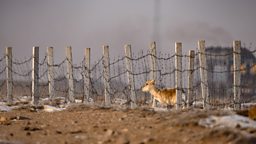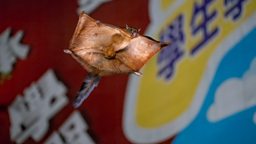Filming wolves and horses on the endless steppe
By Luke Barnett, Cinematographer

The enormity of a filming expedition often doesn’t hit you until you are faced with the realities and challenges of the location. Working on the Arid Heart episode of Asia, I found myself in Mongolia, where the goal was to find and film wolves at night in a landscape that essentially goes on forever.
...the goal was to find and film wolves at night in a landscape that essentially goes on forever.
We wanted to document the wolves’ relationship with takhi (also known as Przewalski’s horses), which went extinct in the wild in the twentieth century. Since their re-introduction in Hustai National Park some thirty years ago, their population has slowly grown to around three hundred named individuals. These are the only truly wild horses in the world (Dartmoor ponies and American mustangs are considered feral). The wolves seem to be re-learning their old behaviour of hunting the takhi under the cover of darkness.
We had timed our visit to coincide with when the foals are born in the earlier part of summer – which is still a brutally cold time of year. The foals stumble about on feeble legs trying to find warmth and milk and somehow keep up with the family group. “Takhi” is a Mongolian word meaning “spirit” or “worthy of worship”. It became apparent working with the rangers just how dedicated they are to encouraging the population to continue to grow. They follow them takhi daily, and meetings would see the rangers sharing food and horse news every evening.

Our camp consisted of traditional gers – beautifully simple round structures with a solid front door, insulated with wool and equipped with a central hearth to keep the bitter cold out. Dark and cosy, it was an ideal home for me in the daytime, where I rested before adventuring out into the night.
We drove along dusty roads to the valley where the takhi would most likely congregate for the night...
It’s always hard heading out to film after sunset. Especially as you pass the daytime crew coming back in. Hearing talk of beautiful foals in golden light and seeing a hot supper being prepared over the fire as you depart is tough. You are left with kind words of good luck from the team and have to muster determination to match the day’s efforts.
We drove along dusty roads to the valley where the takhi would most likely congregate for the night, before local guide Sanj headed off on a motorbike for further scouting. We would base most of our filming around a valley where we knew the takhi would stop to drink, and nibble at the first succulent blades of summer grass.

In filming any interaction with predators it makes good sense to stay with the prey animals when you aren’t sure where their predators are. I spent many nights huddled in that freezing valley in my filming hide whilst my colleagues scanned for wolves with night-vision goggles and kept me up to date by radio.
My main camera for this job was a huge thermal camera
My main camera for this job was a huge thermal camera, weighing about twenty kilos on the tripod. Moving it was tricky without stumbling down marmot burrows in the dark. Its vision in the pitch black is second-to-none, due to its military origins. Seeing this clearly in the dark is certainly a special experience.
Sometimes the wind blew too strongly to allow us to put up the hide. When that happened, we tucked the camera close in besides the car. I would prep the camera in the fading light, readying the spare batteries and preparing spare clothing to put on as the temperature plummeted.

I was accompanied by the park’s wolf biologist, Uuganbayar Ganbold – he was critical to our success. Often in that last light and with the glow of the monitor on his excited face, he would say his happy word: “Fighting”. Mongolian wrestling is one of the country’s favourite pastimes, and Uugana was a big fan. I found myself wrestling him, amongst his giggles and taunts as he endlessly flung me around the steppe. At least it kept us warm and helped us work up an appetite before a mammoth supper of meat for the local rangers, and a bowl of ‘rabbit food’ for me – the lone vegetarian.
I’ll never forget the mournful howls we heard one night.
Through howling winds, rain and then some of the most beautiful starlit nights we followed the behaviour of the takhi until at last the foals started to be born. Newborns nervously started life by their mother’s side. Within days their playful antics saw them venturing further into the dark and closer to risk.
I’ll never forget the mournful howls we heard one night. A lone lingering howl, quickly joined by a chorus. Then, we caught sight of the pack of wolves traversing a mountainside - all instinct and poise, moving with purpose towards the horses.
Fighting freezing fingers and toes, we had watched and waited for over two months in the dark to learn if these “spirit” horses would circle up, face down the wolves and save their foals in one of the most beautiful, yet isolated places in the world.

Wild takhi horses versus a lone wolf
Mongolia's last wild horses defend their foals from a wolf attack.



































